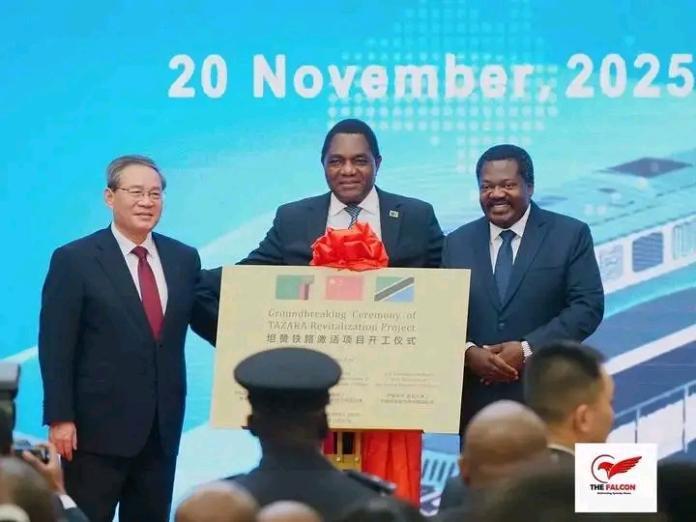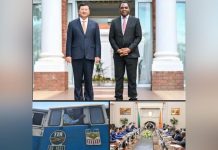Africa-Press – Zambia. Chinese Premier Li Qiang has wrapped up a two day official visit to Zambia, departing Kenneth Kaunda International Airport around 17:37 hours after a day that combined symbolism at State House with hard economic signals on rail, energy and investment.
He was seen off by Vice President Mutale Nalumango, senior ministers and diplomats, in what both capitals are casting as a reset of a six decade relationship for a more competitive era.
At State House, Premier Li praised President Hakainde Hichilema’s reform agenda, telling him that “under your leadership, Zambia has pursued reforms and achieved significant outcomes in economic growth” and that China sees Zambia as “a steadfast partner and a good brother, friend, and ally.”
He said Beijing is ready to “cement political mutual trust, firmly support each other’s core interests, and continue enriching our Comprehensive Strategic Cooperative Partnership.”
The Chinese leader’s language tracked with Beijing’s official line. Xinhua quoted him as saying China stands ready to “carry forward the traditional friendship, deepen mutually beneficial cooperation, promote mutual understanding and affinity between the two peoples, and advance together on the path of modernization.”
The Global Times later reported that Li signalled interest in expanding trade and “tapping cooperation potential” in mining, new energy vehicles and artificial intelligence.
For Hichilema, the visit capped a year in which Zambia completed a 13.4 billion dollar external debt restructuring in which China was the largest official creditor. He used the TAZARA revitalisation launch at Mulungushi International Conference Centre to frame the project as both historic and forward looking, saying the upgrade “carries immense significance for Zambia, just as it did in the 1970s” when the line opened a strategic outlet to Dar es Salaam for a then landlocked and sanctioned economy.
The new TAZARA package, valued at about 1.4 billion dollars and led by China Civil Engineering Construction Corporation, aims to modernise track, rolling stock and operations on the corridor that links the Copperbelt to the Tanzanian coast.
For Beijing, it secures smoother access to copper and cobalt that feed Chinese electronics and energy supply chains. For Zambia and Tanzania, it is meant to cut logistics costs, ease pressure on roads and anchor new industrial zones along the route.
Away from the cameras, a parallel signal landed in Ndola. The Zambia Development Agency handed an investment licence to China Zambia Petrochemical Corporation, a special purpose vehicle jointly owned by the Industrial Development Corporation and Fujian Xiang Xin Corporation, for a 1.1 billion dollar crude oil refinery and integrated energy complex.
The plant will process about three million tonnes of crude per year, roughly sixty thousand barrels a day, which is enough to cover current national fuel demand and create export headroom into the region.
IDC chief executive Cornwell Muleya called the project a “transformative venture” that should “create jobs, enhance national self sufficiency and support long term economic growth,” while Chinese partner Huang Tieming said FJXX is committed to deploying “world class engineering solutions” in partnership with the Zambian state.
For markets, the refinery signals a medium term shift in Zambia’s fuel balance, with potential savings on import bills and new foreign exchange from regional sales if timelines hold.
Zambia’s finance ministry framed the Li visit as a vote of confidence in that broader economic pivot. In a briefing note, the ministry said talks with the Premier would focus on “practical areas that directly impact citizens” including trade, investment, transport, logistics, mining, agriculture, energy and technology.
That list reflects where Chinese capital is already embedded and where Lusaka wants more joint ventures rather than pure lending.
The politics of the visit are rooted in history. Last year marked sixty years of diplomatic ties between the two countries.
Hichilema reminded guests that he and President Xi Jinping had already “reached important consensus” in Beijing on using the Forum on China Africa Cooperation to scale up cooperation, particularly around infrastructure and industrialisation.
Premier Li called Zambia an “important partner on the African continent” whose “natural beauty, friendly people and favourable climate” had left him with a “wonderful impression” on his first trip to sub Saharan Africa since taking office.
But the context is sharper than the ceremony. China has invested an estimated six billion dollars in Zambia over the past two decades, heavily concentrated in mining and construction. Western partners are now countering that presence with their own corridors and climate packages.
The Lobito Corridor, backed by the United States and European Union, aims to move copper and cobalt from the region to Atlantic ports. TAZARA’s revitalisation and the Ndola refinery are Beijing’s answer that it intends to remain central to Zambia’s hard infrastructure story.
For Lusaka, the week closes with both opportunity and pressure. The TAZARA upgrade promises cheaper freight and new industrial nodes if execution is disciplined. The refinery promises energy security if financing and governance remain credible.
The visit also intensifies scrutiny of how Zambia balances its China portfolio with fresh Western finance and its own debt sustainability commitments. Any slippage will be watched by ratings agencies and bond markets still gauging the durability of Zambia’s restructuring.
Premier Li’s motorcade has now left, the flags at Kenneth Kaunda International Airport are being folded away, and attention will shift to implementation. But the images from State House, the TAZARA groundbreaking and the refinery licence handover, many captured by local outlet The Falcon, will circulate as visual proof that China is not retreating from Zambia’s story.
The question for investors and citizens alike is how much of this week’s promise will translate into jobs, lower costs and durable growth over the next decade.
For More News And Analysis About Zambia Follow Africa-Press







